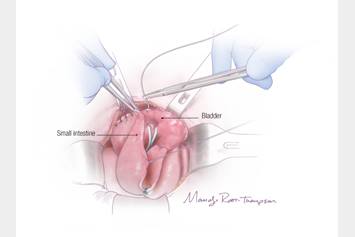The Bladder Exstrophy Program at Nationwide Children's
Treatment and Hope for Improved Continence and Quality of Life
Pioneering New Hope for Bladder Exstrophy Care
Meet Dr. Cuckow
The Bladder Exstrophy Program at Nationwide Children's
Bladder exstrophy is a rare and complex condition, but it is not an emergency. You do not need to rush into surgery. At Nationwide Children’s Hospital, our approach gives you time—time to bond with your child, time to adjust, and time to develop a plan with our experts.
If you choose Nationwide Children’s for your child’s initial bladder closure:
- You’ll experience a novel approach that avoids osteotomies (cutting the pelvic bones).
- There is no need for external fixators, casts or traction, making recovery easier on your baby.
- Within just a week, you’ll be home, where your child belongs.
Our Bladder Exstrophy Program offers a two-step treatment approach for newborns that is truly unique in the U.S. The first surgery to close the bladder takes place when your child is a few weeks to a few months old. Then, between ages one and two, the second procedure, called the Kelly Procedure, creates the sphincter muscles, to more actively allow the bladder to grow. The Nationwide Children's approach leads to shorter hospital stays and better continence outcomes. Our goal is to help children achieve urinary control at a younger age, so they can focus on being kids, not their condition.
Even if your child had the initial closure for bladder exstrophy somewhere else, our team will work with you and your current care to develop a plan using the Kelly Procedure to provide the best outcomes possible.
At Nationwide Children’s, we see beyond just the surgical aspects of bladder exstrophy. Our team is here to support you and your child to bond, grow, and thrive together.
Treating Bladder Exstrophy Conditions in Children
Bladder exstrophy is complicated, and there are several different routes of treatment available. It takes a highly-trained pediatric urologist and a team of health care experts from many specialties to provide the most thorough care for your child. From surgeons to psychiatrists, Child Life specialists and nurses, everyone works together to help your child achieve the best outcome and optimal quality of life.
Parents and caregivers are equally important in the treatment process. No one knows your child better than you do. We make sure you understand the diagnosis all the options available for your child's care. Working together provides the best outcomes for our patients and families. Caring for kids is all we do, and what we do best.
Bladder exstrophy is a lifelong condition. Our team is with your family every step of the way, as you transition from pediatric to adult care.
The Bladder Exstrophy Program at Nationwide Children's treats all types of bladder exstrophy, including:
- Bladder exstrophy: This is the most common form, when the bladder forms outside the body. Shape is more flat than round. Pelvic bones are wide apart/separated.
- Epispadias: This is considered the least severe form of bladder exstrophy. The urethra, the tube that carries urine from the bladder, doesn’t develop the right way.
- Cloacal exstrophy: This is a more complex form, when the genitals, bladder and rectum don’t separate and remain in one hole or channel.
- Any variation of the bladder exstrophy-epispadias complex (BEEC)
Meet the Bladder Exstrophy Program Team
It's not just who treats your child that makes a difference at Nationwide Children's. It's how your child is treated here. Helping children and teens feel better is our purpose and what drives us each day. It's why we do what we do. From evaluation to treatment to recovery and beyond, a team of specialty experts is required to ensure the best outcome.
Your child's care will be led by a pediatric urologist. The team may also include surgeons, physical therapists, nurse practitioners, nurses and other specialty physicians based on your child's diagnosis and treatment needs. The pediatric Urology team at Nationwide Children's has extensive experience with complex urological reconstruction.
Featured Providers

Peter Malcolm Cuckow
Peter Cuckow, MB, BS, FRCS, leads the Bladder Exstrophy Program. He is a renowned specialist in pediatric urological and surgical conditions. With 25 years of experience, he has dedicated his career to providing families with consultation, surgical expertise and innovative approaches to provide the best possible outcomes. Internationally recognized for his surgical capabilities, Dr. Cuckow is particularly known for his mastery of the Kelly procedure for bladder exstrophy.

V. Rama Jayanthi
Rama Jayanthi, MD, is a physician within the Department of Pediatric Urology at Nationwide Children’s Hospital and a Clinical Professor of Urology in the Department of Urology at The Ohio State University College of Medicine. He is also Chief of Urology at Dayton Children’s Hospital. Dr. Jayanthi is a board certified pediatric urologist with expertise in all aspects of the medical and surgical management of genitourinary problems.

Jennifer A. Hansen-Moore
Jennifer Hansen-Moore, PhD, ABPP, is a psychologist in Pediatric Psychology at Nationwide Children's Hospital. Dr. Hansen-Moore provides psychological support to patients with bladder exstrophy and other complex urological conditions that impact urogenital development and/or fertility. Her research focuses on youth with a urogenital or fertility difference.
Treating Bladder Exstrophy in Children
Children with bladder exstrophy are totally incontinent. Traditional treatment approaches can include multiple reconstructive surgeries, including a pelvic osteotomy to reshape the pelvic bones to help close the bladder, reconstructing the urethra to improve urine flow and bladder capacity, and improving the external appearance of genitals. These procedures lead to hospital stays and recovery times that can vary from 4-8 weeks.
Nationwide Children's is the only hospital in the United States to offer the Kelly procedure, which is a soft tissue reconstruction approach to treating bladder exstrophy. Hospital stays following the Kelly procedure are usually around 8-10 days after surgery. Regardless of the approach that would be best for your child, our goal is to make children with bladder exstrophy continent (able to stay dry) by the time they go to school.
Featured Treatments
Of those who received the Kelly procedure from Dr. Cuckow at Great Osmond Street Hospital, over half of children were dry during the day time within three to five years of the operation, rising to 85% after 10 years. Around one-third of children were dry both day and night after three to five years, rising to nearly 60% within 10 years.
The Kelly procedure differs from the traditional surgical treatment for bladder exstrophy that involves a pelvic osteotomy. With an osteotomy, the child stays in the hospital, in traction, for up to two months. This treatment approach is sometimes called a "complete repair." The bladder and abdomen are closed and the urethra and outer sex organs are repaired during a single surgery.
Following the Kelly procedure approach, the child has a first surgery to close the bladder around two to three months of age. Around 12 months, a second surgery at Nationwide Children's would include the Kelly procedure as well as penile surgery for boys.
The Kelly procedure is also called radical soft tissue mobilization (RSTM). This technique involves rebuilding the soft tissue of the bladder neck. It uses the child's own existing muscle and soft tissue to create the new neck of the bladder. This ring of muscle then works like a sphincter to open and close bladder. This helps to control the flow of urine. This helps to hold urine in the bladder and form a strong urine stream. The Kelly procedure creates a sphincter because a natural one did not form. Your child will stay at Nationwide Children's for about eight days. After the procedure, continence develops over the next few years. The end goal is to have the child completely dry by the time they enter kindergarten.
Follow-up Care After Kelly Procedure
In some of the boys the end of the penis will need some further surgery to bring the urethra to its tip.
Follow-up examinations under anesthetic are performed to review the bladder outlet if continence is delayed or difficult to assess. Occasionally bulking agents can be injected at this time to help the outlet resistance of the bladder.
Patients who fail to achieve continence will be offered conventional surgery to make them dry. This would be a bladder neck reconstruction, ileocystoplasy and formation of an appendico-vesicostomy (Mitrofanoff channel). This will be offered to around 20% of patients. They will need to use a catheter to regularly empty their reconstructed bladders for life.
Older girls may require some surgery to their vaginal openings as teenagers. This is because they may be small or because of pooling of urine inside that masks their continence.
Why Choose Nationwide Children's to Treat My Child's Bladder Exstrophy?
When it comes to treating bladder exstrophy and epispadias in children, Nationwide Children's is the only hospital in the United States that is able to offer the Kelly procedure.
Can I Transfer My Child's Care to Nationwide Children's?
If your child is not diagnosed here, you can still request to speak with the team at Nationwide Children's. Even if your child had their first surgery at another pediatric hospital, it's never too late to connect with our team to learn about your child's options.
Leading the Way to New Treatments and Outcomes Through Clinical Research
Clinical care and research work together. This helps scientists and doctors to find new treatments and therapies. Clinical studies (also called clinical trials) will continue to become more common in daily care at Nationwide Children's. Clinical studies help doctors learn more about conditions and treatment.
This means you might hear about a clinical study that your child might be able to join. This does not mean that your child has to join a study. You always have the choice about whether or not to join a study.
Becoming a Patient
We understand that this can be a difficult time. At Nationwide Children's, our team is here to support you and your family every step of the way.
New Patients
Whether you have a child that was newly diagnosed with bladder exstrophy, you want to explore all your options, or you are in need of a revision, our team is here to help. Call us at (614) 722-6250.
Explore our bladder exstrophy blogs on 700 Children's.


Conditions We Treat

Pioneering New Hope for Bladder Exstrophy Care
Nationwide Children’s Hospital is proud to welcome Peter Cuckow, MB, BS, FRCS, to our pediatric urology team. With 25 years of experience, he has dedicated his career to providing families with consultation, surgical expertise and innovative approaches to provide the best possible outcomes. Internationally recognized for his surgical capabilities, Dr. Cuckow is particularly known for his mastery of the Kelly procedure for bladder exstrophy.




